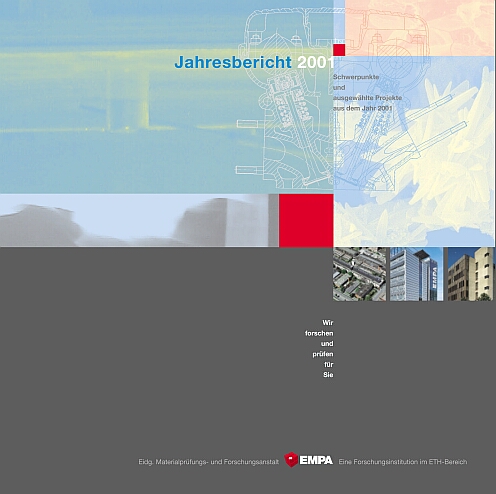Annual Report 2001 now available
Increase in Research Funding
Empa (Swiss Federal Materials Testing and Research Laboratories) now has a new structure, planned and introduced over the period 2001–2002. The five new scientific-technical departments, together with a logistics department, underscore its position in the Swiss research scene.

|
Aside from regular federal funding, an additional CHF 19.9 million flowed into the Empa's coffers, a sum which exceeded last year's amount and emphasizes the trust which the organization enjoys as a research partner. About half this amount originated from industrial sources, the other half coming from other research institutions, public funding and European research programs. A particular source of satisfaction for the Empa, which has a staff of 770 (of whom a quarter are female), is the significant increase in scientific output in the form of contributions to peer-reviewed journals. The Empa-Academy, our center for knowledge transfer, has also shown encouraging development, having practically doubled its visitor count to 3700 in the second year of its existence. The enhancement of Empa's research activities is the result of three essential measures introduced by CEO Prof. Louis Schlapbach. First, initiated by the ETH Council's Innovation and Co-operation Projects, a program concentrating on key areas having significant internal and external synergies was defined. The selected subjects include nanotechnology, adaptive materials, technosphere/atmosphere, sustainability in the information community, and materials for the protection, comfort and health of the human body. Second, the Empa has set aside a significant part of its research budget for internal projects, the quality of which have been improved by stringent evaluation criteria. Finally, recruitment has been almost exclusively limited to research oriented personnel. |
||
|
The departments and their mainstream activities Projects which demonstrate how highly effective and completely novel solutions to industrial problems can be found, as a consequence of nanotechnology research, are being realized in the «Advanced Materials and Surfaces» department. Another key area is «Materials by combination», in which components are specifically modified by surface engineering. The aim is to create new perspectives (in an applied sense) by working together with internationally successful Swiss industry. The «Materials and Systems for Civil Engineering» department supports the national energy, resource and environmental policies in the construction and engineering sectors. The focus here is on the reduction of energy and consumption of resources by the development and technical evaluation of new materials, systems and processes, together with their application to solve practical problems. Functional textiles and biocompatible materials in combination with health and safety are the watchwords of the department for «Materials and Systems for Physical Protection and Comfort of the Human Body». The key activities in this field are the development of appropriate materials and products together with advanced analytical and investigative methods. The «Information, Reliability and Simulation Technology» department aims to take a leading role in interfacing between experimental investigation and modeling and simulation techniques. A notable success was the «Care Electronics Materials and Aging» project, in which tools were developed to support the electronics industry in its efforts in recycling and reuse of components. The project was honored by Eureka on June 27, 2002 in Thessaloniki with this year's Lillehammer Award. Sustainable development is based on sustainable mobility. In the «Mobility and Environment» department therefore, the emphasis is on the study of the flow of pollutants which are produced as a by-product of our mobility. Gaseous pollutants, in exhausts and the atmosphere, are characterized and techniques being developed to reduce them. Related topics of significance in this context are vehicle technologies for the 2000 Watt Society, the further development of exhaust treatment techniques and the use of data from satellite-based instrumentation in the measurement of atmospheric pollution. |
||
|
Editor: Robert Helmy Note: For a more comprehensive and detailed scientific description of Empa's research programs and projects please see the English-language brochure «EMPA Activities 2001» , available as of March 2002. |
||
|
||||
